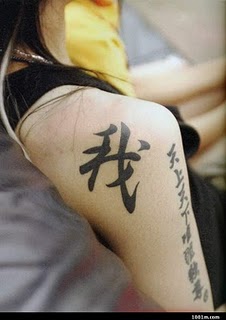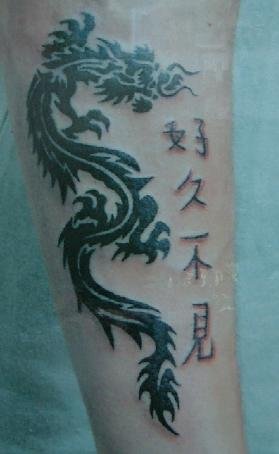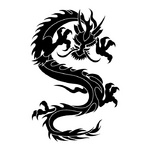Overview About Chinese Tattoos History
 Chinese tattoos and especially the Chinese characters tattoo have been very popular in the Western world the last decade or so, and they still are today. Chinese characters are beautiful little pieces of art. They are exotic and mysterious, what makes them very suitable for a tattoo design. No wonder you see so many Chinese symbol tattoos around these days.
Chinese tattoos and especially the Chinese characters tattoo have been very popular in the Western world the last decade or so, and they still are today. Chinese characters are beautiful little pieces of art. They are exotic and mysterious, what makes them very suitable for a tattoo design. No wonder you see so many Chinese symbol tattoos around these days.
There’s more to Chinese tattoos than just the symbol tattoos, although tattoos have quite a negative connotation in traditional Chinese culture. In fact, there was a belief that the body is a sacred gift from one’s parents and should not be altered in any permanent way which of course includes tattooing.
Ci Shen – Chinese Tattoos
The art of tattooing has been known in China for thousands of years. Tattooing in China is called Ci Shen (Or Wen Shen), a term that means literally “puncture the body.” Although the art has been known in China for ages, it has for the most part been an uncommon practice. Throughout Chinese history tattooing has been seen as a defamation of the body, something undesirable.
 Water Margin, one of the four classical novels of Chinese literature, does reference tattooing. Water Margin tells the stories of bandits of Mount Liang area of China during the early 12th century. The novel talks about the 108 companions of the historical bandit Song Jiang. Three of these characters are referenced as having tattoos covering their entire bodies.
Water Margin, one of the four classical novels of Chinese literature, does reference tattooing. Water Margin tells the stories of bandits of Mount Liang area of China during the early 12th century. The novel talks about the 108 companions of the historical bandit Song Jiang. Three of these characters are referenced as having tattoos covering their entire bodies.
The most famous tattoo in Chinese history comes from the legend of the Chinese general Yueh Fei. Yueh Fei served the South Song Dynasty. During battle with northern enemies the Field Marshall under whom Yueh Fei served betrayed the South Song and went over to the enemy.
In protest Yueh Fei resigned and returned home. His mother grew angry with him, telling him that his duty was first and foremost to his country, despite all else. To remind him of this fact she tattooed four characters on his back with her sewing needle. These characters, jin zhong bao guo, are difficult to translate but mean something like “Serve his country with ultimate loyalty.”
At some points in Chinese history Chinese tattoos were also used to mark criminals. Criminals convicted of a severe crime would be ordered to have a tattoo printed on their face and exiled into a faraway land. Even should the criminal ever return the tattoo would mark them forever as a criminal? This form of punishment was known as Ci Pei (Tattoo/Exile).
In modern China Chinese tattoos have grown somewhat of a stigma as being affiliated with organized crime and the criminal underworld.
The Chinese tattoo doesn’t have a very interesting history, but there are several ethnic minorities in China who do have a strong tattoo tradition. The most important ones are the Drung, Dai and Li tribes.
Drung Tattoos
The Drung are an ethnic group that live in the Yunnan province. The woman of the Drung tribe used to tattoo their faces when they reached the age of 12, as a symbol of maturity. The tattoos were done between the eyebrows and around the mouth, resembling a butterfly or diamond design.
About 3 centuries ago, the women of the Drung tribe were often attacked by other ethnic groups and to avoid being raped, they used tattoos to make themselves less attractive. Some of these tribal tattoos resembled moustaches.
Of course, modern tattoo equipment was not available 300 years ago, thorns were used to puncture the skin and charcoal was used instead of tattoo ink.
Dai Tattoos
The Dai are also an ethnic minority living in southern Yunnan. Children as young as 5 were tattooed, and then again at the age of 14, as a symbol of sexual maturity. Men were tattooed on strong muscles, woman between the eyebrows or on the hand or arm. Black tiger tattoos or dragon tattoos were the most popular designs. The people of the Dai tribe used their tattoos as a talisman, to keep monsters away.
Li Tattoos
The Li are an ethnic group living in tribes on Hainan Island. Tattoos play an important role in the Li women’s life (both sexes were tattooed, although it was more common for women) and their tattoo tradition can be traced back to 3000 years ago.
When girls reached the age of 12, they receive their first tattoos on the neck, face and throat. Over the next several years, the girl’s arms and legs were tattooed as well. The tattoos meant that they were ready for marriage, they were a rite of passage.
Men were tattooed as well, but for medicinal purposes.
A Beginners Guide to Chinese Symbol Tattoos
The practice of Chinese tattoos all started more than 4000 years ago. Chinese writing relies heavily on a large number of symbols instead of alphabets and these symbols represent many spoken concepts or ideas. So, each Chinese symbol that you know of today, represents a different spoken idea or word.
In 1710 AD, the Kangxi dictionary was created upon imperial decree and contained in it nearly 50,000 different symbols. Since then, this number has grown to almost 75,000 symbols and is still growing numbers till date.
Having said this, it must be noted that the average Chinese person must only know around 5,000 of these symbols in order to read, understand or write anything in the ancient language. Because there are so many symbols available today, almost anything can be translated into Chinese. Even the subtlest of all nuances and meanings can be translated by using a combination of these Chinese symbols.
Hanzi and Kanji
Hanzi is the name for the traditional Chinese characters used in the official written language of Hong Kong, Taiwan, Macau and Chinese communities out of China.
There are about 47,000 Hanzi characters, but many of them are unused. To be fully literate, you need to know about 4000 of these Chinese characters. Most Chinese words are written with multiple characters, one for each syllable.
Besides traditional Chinese there is also Simplified Chinese, an attempt to increase literacy in China. Simplified Chinese characters have less number of strokes than traditional Chinese. They are used in mainland China, Malaysia and Singapore.
Chinese Dragon Tattoos
Chinese characters tattoos are not the only type of Chinese tattoo that is popular today. Chinese dragon tattoos are very popular as well.
The Chinese dragon is a long snake-like creature, usually with 5 claws and without wings. As opposed to Western beliefs, the dragon in Chinese culture is a benevolent creature that wards of evil spirits. It symbolizes good luck, fertility, happiness and immortality.
In Chinese culture there is the belief that wearing the image of a dragon on you is considered very unlucky. The Chinese symbol for dragon on the other hand is considered lucky. Sometimes you see a person with a tattoo of a dragon combined with the Chinese dragon character. This always reminds me of these picture books that are used to teach children how to read. Imagine a tattoo of an eagle with the English word ‘Eagle’ below it, kind of silly, not?


